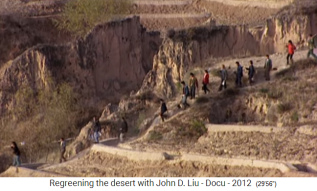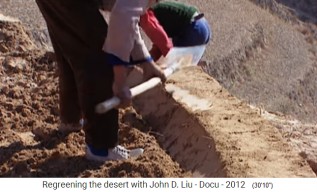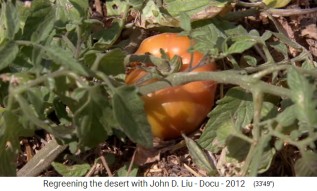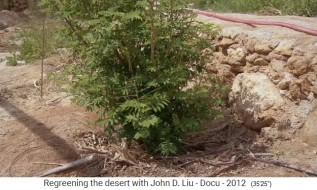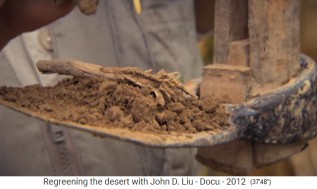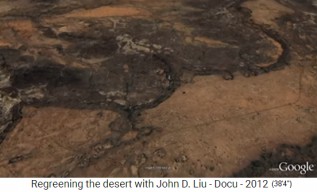7) Jordan: The desert around the city of Petra
Today the city of Petra is largely ruined in a desert
(25'31''). In former times an oasis was maintained here
which was the source for the city (25'44''). Here John D.
Liu met the Australian Geoff Lawton, a specialist for the
revitalization of ecosystems (26'13''). The desert around
Petra has degenerated down to the foundation stones, but
was certainly once a blooming landscape (26'43''). And
there are still wild animals in the valleys, the remains
of a fertile overflow landscape (27'0'').
The city of Petra in Jordan, John D.
Liu and Geoff Lawton - in the region Petra - the region
of Petra consists only of bare mountains
Desert states like Jordan are trapped in a cycle of
poverty. When the landscape is renaturalized, the next
generations will have a much better life (28'28''). Life
becomes safer and cultural wealth is increasing (28'39'').
8) China: The renaturation of the Loess Plateau (Lush
Plateau) since 1995
In 1995, the 2.5 million people of the Loess Plateau had
to be convinced that they should stop keeping their cattle
outside and drifting over the hills, but keep the cattle
inside to preserve the landscape (29'2''), to give nature
time to recover (29'5''). The local bosses, the bosses of
the cattle herds, were sceptical, but the farmers wanted
to realize the program because it was their land
(29'58'').

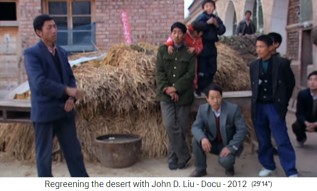

The Loess Plateau in China: The
cattle herds eat everything - The Loess Plateau in
China, the local animal traders - The Loess Plateau
in China, a government official instructs the animal
traders



The Loess Plateau in China, other
animal traders - The Loess Plateau in China, a funny
farmer - a farmers' meeting
The measures to renature the Lush Plateau:
-- The slopes were stabilized with shrubs and trees,
-- The terraces were equipped with dams and ditches in
front of them to stop the rainwater (30'26''), and
-- Even on less inclined slopes, dams were built with
ditches in front of them to stop the rainwater (30'34'').
-- Mountains have been defined as nature reserves
protected zones where agriculture is not allowed. The
farmers were even compensated (31'5'').
-- And the livestock had to live on much less land
(31'12'').
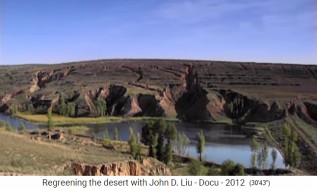


China Loess Plateau, large dam blocking the water
forming a pond, here the water seeps into the ground -
China Loess Plateau, terrace with dam 02 - China Loess
Plateau, fresh terraces on sunny slopes

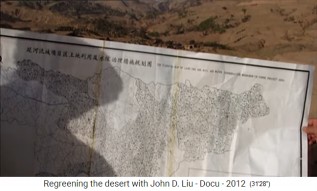
China Loess Plateau, farmers now keep their cattle on
the farm - China Loess Plateau, map of ecologists


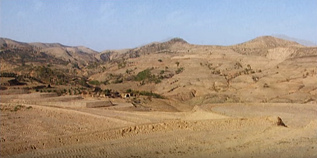
In 1995, the Loess Plateau in China is still a desert
1,2,3
 In 1995, the Loess Plateau in China
is still a desert, p
In 1995, the Loess Plateau in China
is still a desert, panorama photo


 China, the regenerated Loess Plateau
2012 1,2,3
China, the regenerated Loess Plateau
2012 1,2,3

China, the
regenerated Loess Plateau 2012, panorama photo
China Loess Plateau, valley with
desert soil in 1995 - China Loess Plateau, the
valley in 2012 is regenerated and completely
overgrown with greenery
9) Jordan: A permaculture garden in Jordan's
desert - renaturation in 3 years -
self-sufficiency and autarky in 5 years
Jordan: Permaculture ecologist Geoff Lawton has set
up a vegetable gardening school in Jordan to teach
the population to grow vegetables on desert soil
(32'18''). Since food prices are high, it's worth
it, and suddenly Jordanian families have their own
vegetable garden and enough to eat (32'34'').
Permaculture with Geoff Lawton -
Jordan, permaculture garden with striped fields -
Jordan, permaculture garden with large cabbage
The permaculture vegetable garden is laid out in a way
that in 3 years it will become a completely
self-sufficient ecosystem (33'48''), without irrigation,
[this means: WITHOUT watering (!)], and new springs will
come up (33'53''). The garden is fully fertile, even in
the dry season (33'58''). After 3 years also all kinds of
herbs grow in the garden (34'6''). Here is a great
diversity that plays together (34'11''). The permaculture
garden is designed by Lawton from Australia. In the end, a
self-sufficient ecosystem is created that functions
completely independently (34'31'').
Jordan, permaculture garden, gauze is
wrapped around plants 01 - Jordan, permaculture garden,
shrub with gauze all around - gauze was wrapped 02
In a permaculture garden there are no pesticides or
fertilizers, and fruits and vegetables grow in abundance
(34'37'').
[Permaculture agriculture: The roots
remain in the soil, along these roots water is seeping
into the soil thus the earth is always humid, and these
roots are turning into valuable soil, as does the
organic matter (gauze) that is placed around the plants
to cover the soil. This means that the soil always
remains moist and does not need irrigation. The varied
small field economy also allows the planting of many
different vegetables in a small territory, combined with
trees and shrubs, so that the beneficial animals of many
vegetables, trees and shrubs are combined in such a way
that no pests can dominate. All plants in this earth are
very strong, they are growing much faster and fruits and
vegetables are much bigger, and considering the hill
form of the patches and beds which is rising the surface
by apr. 20% the harvest is 10 times more per m2 than
with normal chemical machinized agriculture - and the
costs are lower. With enough shrubs and trees the
biomass for organic matter (gauze) can be produced on
the spot after about 5 years].
In 5 years the trees will have grown in such a way that
even all the mulch can be produced (35'7''). In 3 years
the self-sufficiency is there, and in 5 years the complete
self-sufficiency is also there with the gauze (35'38'').
The beds are arranged in parallel strips, always with
different varieties (35'48''). Compost feeds the
terrestrial organisms, 50 million different bacteria and
50 million different fungi (36'17''). These organisms work
together with the plants so that the plants grow better
(36'28'').
Permaculture garden in Jordan, the
stripe fields 2,3,4
10) China, Loess Plateau with permaculture
The ecosystem on the Loess Plateau in China functions so
well that even the worst drought is survived well
(36'51'').
China Loess Plateau
2012 with field farming, everything has turned green -
China Loess Plateau, best harvest, status 2012
Every leaf that remains is left behind and is food for
the soil and for the soil population (37'3'') so that
the soil remains moist and contains enough carbon
(37'7''). This living earth can store 3 times more
carbon than the leaves on the ground (37'52'').
The permaculture
soil on the Loess Plateau is best soil - close-up 1.2
And in this way one can renature the deserts of the
whole world. One can view these wide desert landscapes
on google Earth (38'5'').
Google Earth: Desert landscape in
Chile - desert landscape in Africa in the Sahel - desert
landscape in Central Asia - desert landscape in India
Much carbon is retained (38'10''). Also, other problems
will be solved automatically, and each generation will
have it a little better (39'33'').



John D. Liu - China Loess Plateau, regenerated and green
1,2


China Loess
plateau, vegetable growing on wide terraces on
transverse dams (permaculture) 1,2
The Lush Plateau [Loess Plateau] in China has become
a green garden, also with greenhouses, and the
supply on the market has become huge (40'11'').
Income have tripled (40'25'').



China Loess Plateau, high-quality production
also in greenhouses - China Loess Plateau,
market 01 with eggplant and chili - 02 with
chili and salad

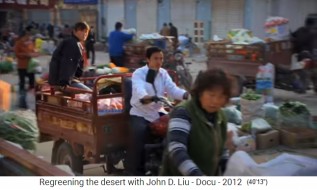

China Loess Plateau, market 03 with tomatoes and
aubergine - 04 with a new delivery - 05 with
leeks, carrots, peppers etc.


China Loess
Plateau, market 06 - China Loess Plateau, market
07, a box of sweet potatoes
11) Renature all the deserts of the world
John D. Liu: When ecosystems are renatured and
people have understood this, the future on the
planet will be glorious (41'15''). But if money is
always based on consumption and people remain idiots
and know nothing about nature, then people will turn
landscapes into deserts again and again (41'21'').
Quote Liu:
"Weath is being happy, living in nature,
listening to the birds, breathing clean air
(40'45''), not having chemical pollution throughout
everything, not having these horrible problems
(40'51''). So, you know, we need to redefine and
revalue our belief systems (41'0''). We need to
understand that money is a belief system (41'3'').
There's nothing wrong with money, it turns out. The
problem is that what is money based on (41'9''): If
money is based on functional ecosystems, then the
future will be beautiful (41'16''). If money
continues to be based on production, consumption of
goods and services, [it] will turn everything into a
desert (41'23''). What is the future for our
children and our children's children and generations
to come in the future?" (41'28'')
[It is important to give Mother
Earth the first priority in life and not materialism
with its selected products traded on the stock
exchange].
There are still stupid governments destroying
forests:
12) Bolivia with slash-and-burn - people there
don't know anything about permaculture yet
In Bolivia, mountains are still burned down today to
gain agricultural land. This only works for a short
time, and then the landscape will be devastated by
rain because the humus will be washed away (42'3'').
Bolivia with
slash-and-burn 03, aerial photo - Bolivia with
slash-and-burn 04, only tree stumps remain
13) The proposal of biomass exports
from tropical zones to dry zones for the renaturation
of desert landscapes
Liu: The tropical zones could collect biomass and export
it to dry zones. This would keep people busy, so nobody
in the tropics would have to burn down rainforest any
more (43'2''). By slash-and-burn, the most valuable part
of the ecosystem, biomass, is simply burned down and
destroyed (43'10''). In the arid zones, there could also
be a great deal of activity to restore the ecosystems.
So this would occupy people in the tropics AND in the
dry zones, and both would be better off (43'22'').
Rainfall would increase, the soil could store more
carbon, the world would have absolute food security
(43'37'').
Many people who run gardens have not understood
permaculture yet and think that biomass is "dirt" and
burn it (44'8''). And so they have no additional
nutrients for the soil and go into the negative spiral
(44'18'').
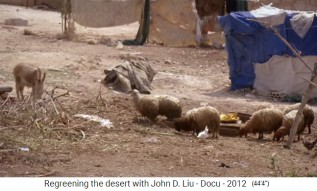
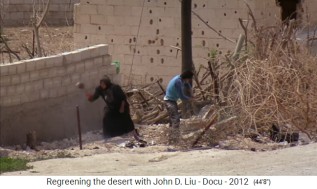
Jordan: Animals eat organic material
- Jordan: Ignorant people burn organic material
Anyone can create a permaculture garden (44'55''). And now
the landscape has to be renatured worldwide (44'59''). So
one has to teach the masses in order to bring them on the
positive way to nature, into a positive relationship
(45'19''). And so the existence of humanity on this earth
is guaranteed (45'40''). If this turnaround fails to
materialize, there will be millions of migrants moving to
places where there is still food (46'4'').










